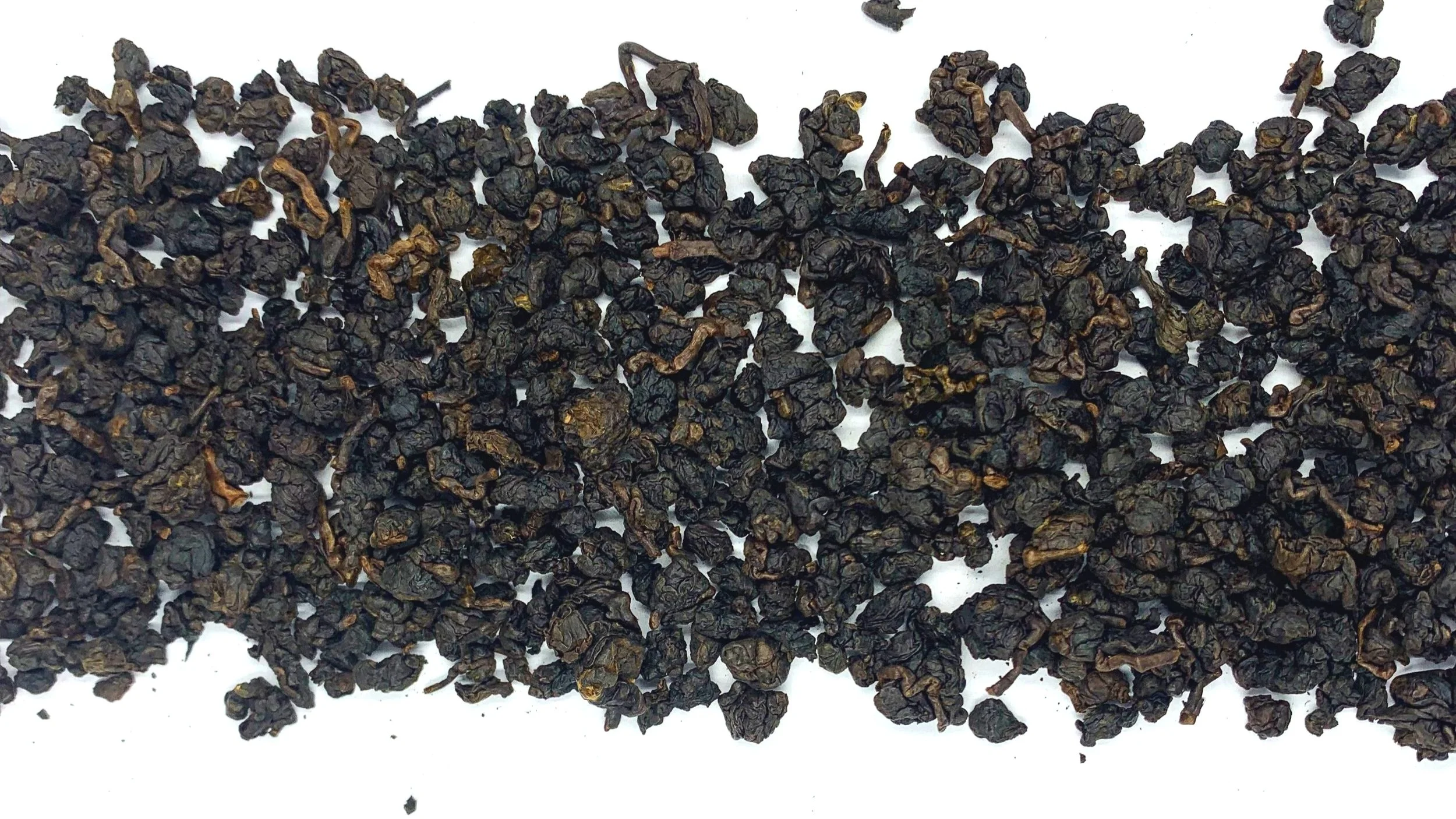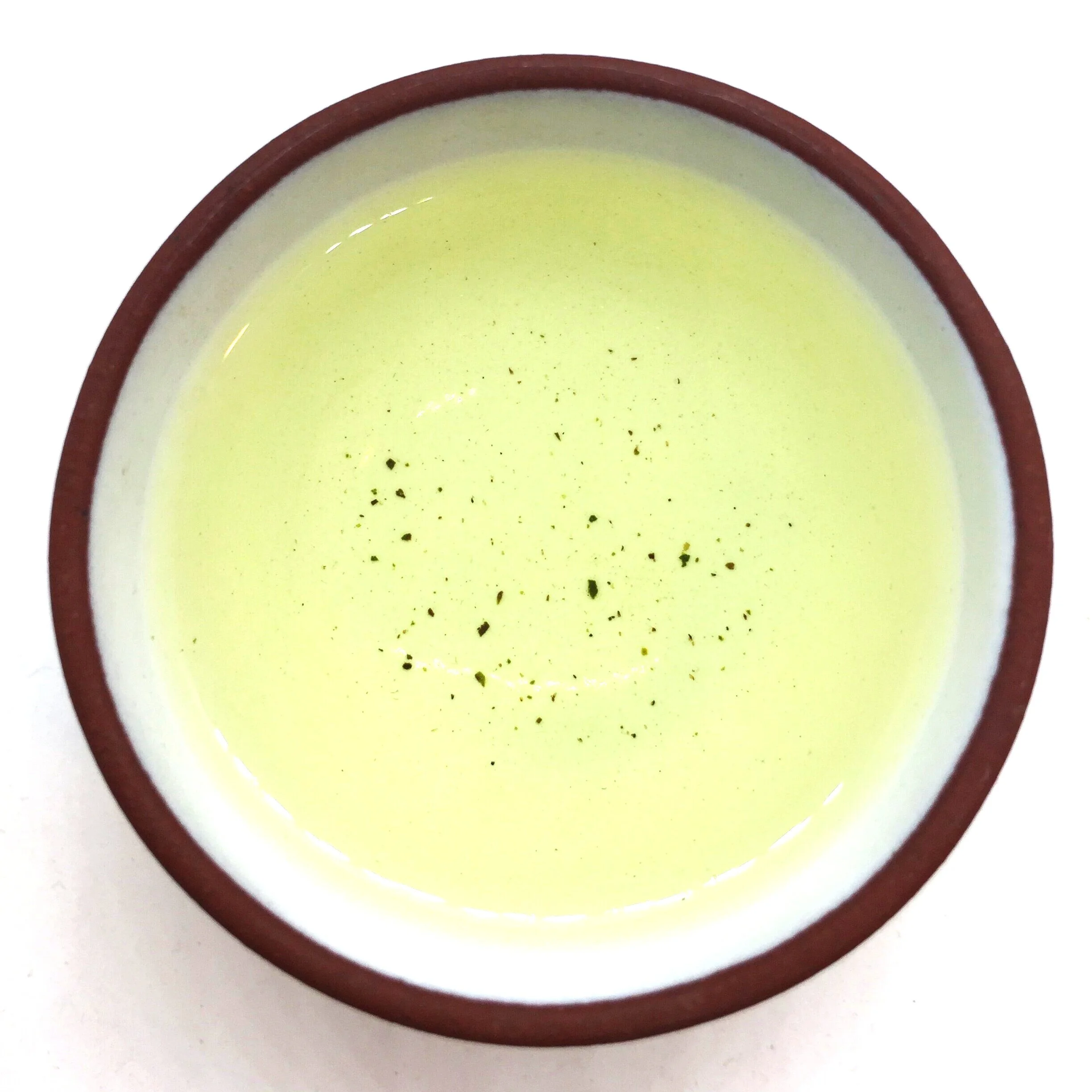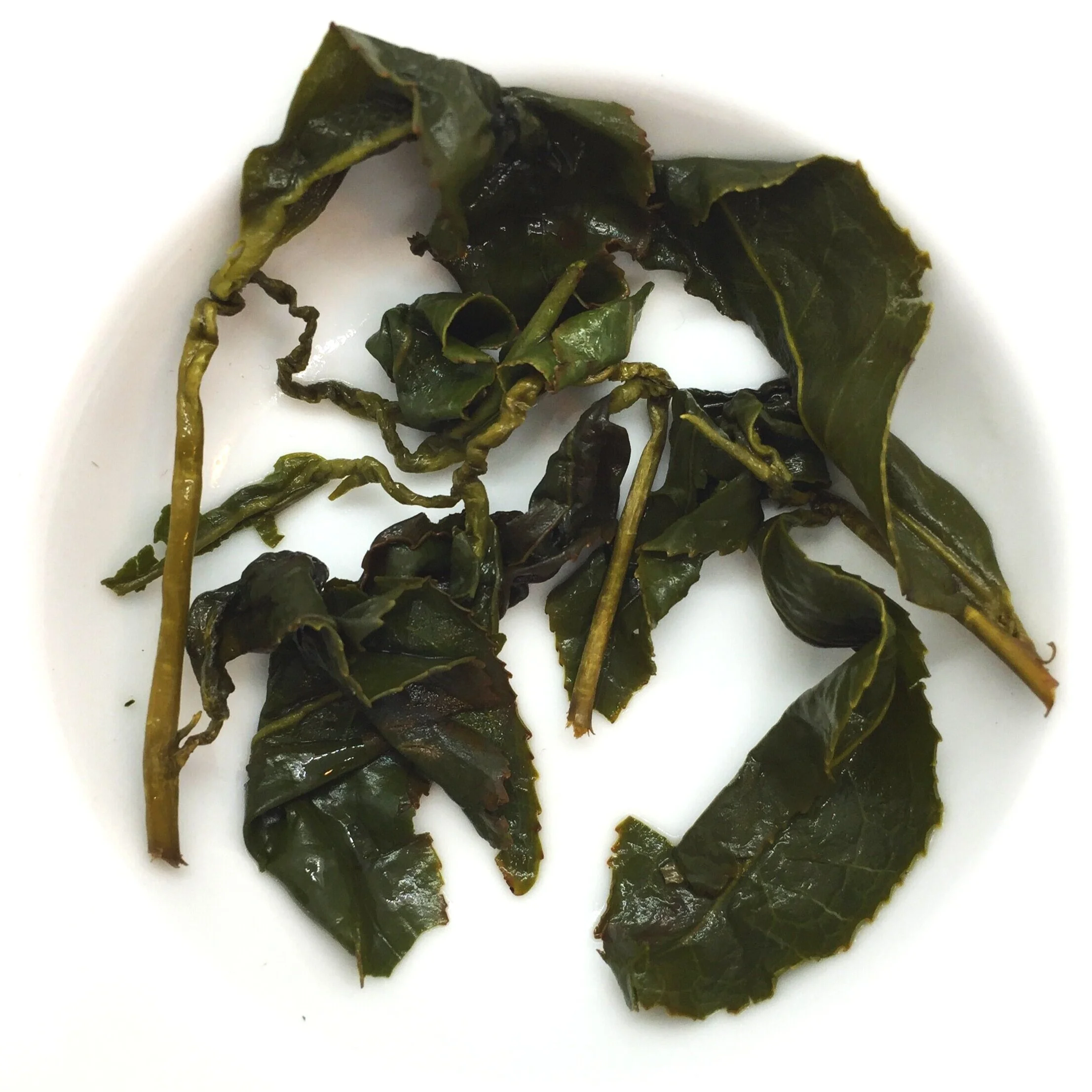Shan Lin Xi
Shan Lin Xi
A very refined example of Taiwan high mountain oolong, the Shan Lin Xi is grown at an altitude of 5,250 feet. It is creamy and complex, and perennially popular in our cafe.
The harsher growing conditions which high mountain oolongs are exposed to increases their concentration of nutrients, and less sunlight increases the level of chlorophyll in the leaves. Teas such as this are bursting with flavor which unfurls across each steeping as the masterfully processed leaves open to water.
Origin - Nantou, Taiwan
Harvest- Late April 2023
Elevation - 5,280 ft
Varietal - Qing Xin
Tea Maker - Mr. Chen
Tastes Like - Lilacs, Green Peas, Ghee Butter
Sold in one ounce increments
The Name “Shan Lin Xi” (杉林溪)
The words “Shan Lin” (杉林) mean “pine forest.” More generally, “shan” (杉) can refer to pines or various types of fir trees, so this could also be translated as “cypress and/or cedar forest,” as various types of these trees are all found in the region. Xi (溪) refers to a small mountain stream. So the name is suggestive of the type of mountain environment in which this tea is grown, and could be translated literally as “Stream of Pine Forest.”
Shan Lin Xi Growing Area
The Shan Lin Xi tea growing area is located in Zhushan (竹山), in Nantou (南投) County. The tea gardens range in altitude from between 1,100 meters and 1,900 meters above sea level. Shan Lin Xi is considered one of the three major high mountain tea areas in Taiwan along with Li Shan and Ali Shan.
The Shan Lin Xi area farmers originally used bamboo shoots and rice as their main crops. In the 1970s, tea planting was introduced and due to success in growing high-quality tea and economic development, the planting area of tea has continued to expand.
The Shan Lin Xi tea area is covered with clouds and mist all year round, the environment is naturally unpolluted, the soil is fertile, and the rainfall is moderate with an annual rainfall of 2,700 mm. The annual average temperature is 21 °C which is very suitable for the planting and growth of tea trees. The tea is harvested in spring, summer, autumn, and winter, but spring tea and winter tea are considered the best quality.
Due to the year-round prevalence of clouds and mist in the morning, coupled with the cold evening environment, this tea has a strong "high-mountain fragrance” (高山气味). Mountain cedar and cypress trees and the tea trees grow interspersed, so this tea has a special "cold aroma” (冷香), which is a major feature of high mountain tea.
Characteristics of Shan Lin Xi
Shan Lin Xi high-mountain oolong tea is considered a soft branch “Ruan Zhi” (软枝) oolong, or in other words, the Qing Xin (青心) cultivar is generally used.
Tea Soup Color - Shan Lin Xi oolong tea is generally a lightly roasted oolong tea. Its tea soup is a bright golden color, light and not cloudy, and the taste is smooth and sweet without being astringent.
High-Mountain Charm - A major feature of Shan Lin Xi oolong tea is that it retains a distinct "mountain fragrance," which refers to the unique aroma of the tea formed on each mountain due to different geographical and climatic conditions. Even if the same tea tree is planted on different mountains, it will give birth to a completely different fragrance.
Fragrance - When drinking Shan Lin Xi tea, one experiences a touch of floral fragrance at the beginning, and is left with a touch of honey fragrance at the end.
Indigenous Peoples of Shan Lin Xi
Shan Lin Xi mountain is home to Taiwan’s largest indigenous group, known as the Amis (also known as the Pangcah). They are an Austronesian ethnic group which makes up about 37% of Taiwan’s indigenous population. For hundreds of years the Amis have cultivated high-mountain tea, which they used as a healing remedy. Amis are primarily fishermen, due to many living near the coast. They traditionally had a matrilineal kinship system, and family affairs and financial matters were traditionally decided by the female householder. The most important Amis traditional ceremony is the Harvest Festival in which the people express their appreciation and gratitude to the gods and pray for a good harvest in the coming year.
Taiwanese Oolong Tea
Of all types of tea, Taiwan is best known for its oolong (wulong) teas. Oolong makes up around 90% of all tea produced in Taiwan. In Taiwan, there is a wide range of various altitudes and microclimates among the different tea growing regions, which results in many different styles of Taiwan oolong teas. The top oolongs coming out of Taiwan can easily be considered among the best in the oolong category worldwide.
Taiwanese Oolong History
Due to Taiwan’s proximity to Fujian Province in mainland China and the fact that Fujian is such an important location for oolong tea, it is no surprise then that Taiwan oolong tea has its roots in Fujian. Despite this history, the tea-making process in Taiwan has changed and become unique during the more than 200-year history of Taiwan’s tea industry.
During the Qing Dynasty, Taiwan’s population increased significantly due to immigrants from mainland China, and it was during this time that Taiwanese tea took root. In 1810, a Fujian tea merchant named Ke Chao (柯朝), attempted to grow tea from seed in Taipei County (台北县) and was successful. After this, tea planting started to become widespread in Taiwan.
In 1858, British and French invasions in mainland China resulted in the Treaty of Tianjin, which stipulated Taiwan as an international trade port. British businessman Jardine Mantheson from Hong Kong sent people to Taiwan to purchase crude tea.
Fujian tea makers originally brought the technique of strip-shaped oolong tea from Fujian to Taiwan. In 1885, two tea makers by the names of Wei Jingshi (魏静时) and Wang Jinshui (王锦水) were well known for bringing the method of fragrant, strip-shaped oolongs to Taiwan, basically the same style of oolong as Wuyi Rock Oolong tea and what is currently the style of Baozhong oolong tea.
In 1868, British businessman John Dodd was impressed by Taiwanese crude tea products and began shipping it to Fuzhou each year for processing and refining. Tea masters from Fuzhou also went to work in Taiwan and various tea production equipment was brought over. It was around this time that Taiwanese oolong tea was shipped to the West for the first time. By 1873 the Taiwanese oolong industry began to flourish with foreign firms competing to buy oolong from Taipei, causing the price of Taiwanese oolong tea to steadily rise.
From 1939 to 1941, two other well-known tea makers, Wang Taiyou (王泰友) and Wang De (王德), passed on the tea leaf kneading skills of Anxi, Fujian to others in Nantou County, Taiwan. At this time, the famous style of oolong known as Dong Ding Oolong (冻顶乌龙) began to gradually evolve into its rolled-ball appearance, and this was coupled with the delicate art of tea roasting.
Since about 1980, high mountain tea (高山茶) has become popular in Taiwan. Tea makers gradually adjusted the tea making method of common oolongs such as Dong Ding oolong, along with a trend towards less roasting in the tea-making process, so as to maintain the fresh mountain flavor of the tea.
Taiwanese Oolong Cultivars
A tea cultivar (i.e. “cultivated variety”) is the result of one of the two tea varieties (Camellia Sinensis var sinensis or Camellia Sinensis var. assamica) that has been selectively bred for certain characteristics. A certain cultivar can then be used with specific tea processing methods to result in specific tea styles. Sometimes specific styles are also associated with specific tea growing locations as well. Each style of tea may have a special name, a name related to the growing location, or may just go by the name of the cultivar itself.
Around 1900 Taiwan was under Japanese occupation, during which time a research institute was created that was called the Taiwan Tea Research and Extension Station (TRES). TRES was created to develop cultivars and educate tea farmers. TRES continued functioning post-occupation and has been responsible for the creation of many of the popular Taiwanese cultivars in use today.
The following are the main Taiwanese oolong cultivars:
Qing Xin (青心) - Qing Xin is one of the most widely used cultivars in Taiwan and also one of the highest quality. It is said to have originated in Jianou City (建瓯市), Fujian Province. Qing Xin is also known as Ruan Zhi (软枝), which means “soft stem.” Qing Xin is usually the cultivar used for Dong Ding, Baozhong (a fragrant strip-shaped oolong), and most of the high-mountain oolongs (Da Yu Ling, Alishan, Lishan, etc.). Qing Xin can also be seen as a category of similar cultivars since there are several “Qing Xin” cultivars.
Qing Xin Da Mao (青心大冇) - Qing Xin Da Mao is not as popular as Qing Xin. It is mostly used for Oriental Beauty oolong and has a sweet, honey flavor.
Jin Xuan (金萱) - Jin Xuan is another of the most well-known Taiwanese oolong cultivars and is often sold by its cultivar name, which means “Golden Lily.” Jin Xuan is known for its creamy mouthfeel and milky aroma “nai xiang” (奶香). There are many “milk oolongs” on the market that are artificially flavored, however, high-grade Jin Xuan naturally has the milky flavor without any adulterants. Jin Xuan is popular amongst lower-elevation farmers, but is also grown by high-mountain farmers on Alishan Mountain. It tends to be cheaper than Qing Xin Alishan.
Cui Yu (翠玉) - “Jade Oolong” is usually sold by its cultivar name. This cultivar is very popular in Asian markets, and is only grown at lower elevations (the stems contain too much water for high-mountain growth). Cui Yu yields better than Qing Xin and its flavor is more towards the floral end of the spectrum and is less creamy than Jin Xuan.
Si Ji (四季) - “Four Seasons Oolong” (or Four Seasons of Spring “Si Ji Cun” (四季春)) is primarily grown at lower elevations and used to create greener oolongs (i.e. low oxidation). It is known to produce fragrant spring-like crops all year round and can even be harvested up to six times per year with its fast growth rate. Si Ji usually has a stronger fruit flavor and aroma than the other Taiwanese cultivars.
Tie Guan Yin (铁观音) - The Taiwanese Tie Guan Yin cultivar is processed differently from the well known Tie Guan Yin of mainland China. The Taiwanese version is usually roasted and sometimes aged, and it is the most expensive Taiwanese cultivar.
Fo Shou (佛手) - Fo Shou is another oolong that is also popular in mainland China and is sold as its cultivar name. It is known for its very large leaves.
Bai Mao Hou (白毛猴) - This is a cultivar that is usually used for Oriental Beauty oolong.
Taiwanese Oolong Tea Processing
Picking 采摘
There are two types of tea picking: mechanical-picking and hand-picking. Generally, tea gardens with lower altitudes will choose "mechanical harvesting" to reduce labor costs, but some high mountains will also consider the mechanical harvesting of mature tea leaves.
Most of the tea gardens at high mountain altitudes choose to hand-pick the tea leaves, which can reduce old leaves or excessive branches and maintain the quality of the tea.
Withering 萎凋
(Solar Withering 日光萎调→ Indoor Withering 室內萎凋) The freshly harvested tea leaves contain a lot of water (75% to 80%). After the tea leaves have withered, the water will dissipate and evaporate by 8% to 12% due to the rising temperature of the leaf surface. The oxidation reaction on the leaf surface will start to change the leaves.
Solar Withering This means that the tea leaves, after being picked, are usually set out in the sun to oxidize and let the water content reduce. After the water partly evaporates using sun withering, the leaves will give off a nice scent.
Indoor Withering The tea leaves are flattened on a shelf indoors to an appropriate thickness, and then the leaves are lightly flipped at an appropriate time (requires a lot of standing work). Next is to wait for the tea leaves to slowly drain to remove the bitterness and astringency so that the tea leaves will have a pleasant aroma and a sweet taste.
Laying and Tossing 做青/摇青
After the tea leaves have withered, they must be stirred in a timely manner and rotated in a machine (or manual-stirred as an alternative) to rub the leaf cells, so that the polyphenol oxidase and various tea polyphenols come into contact with other tea polyphenols, and an enzymatic oxidation reaction occurs.
Stir Fixation 炒青
Stir-frying is a turning process that links the previous step to the next, and it is also an important step in the formation of the oolong tea’s endoplasmic aroma. The effect of stir-frying on oolong tea is similar to that of green tea, which inhibits the activity of enzymes, prevents the leaves from continuing to oxidize, and ensures the lasting quality of the oolong tea.
Rolling 揉捻
The purpose of kneading is to inflict stress in a controlled way and essentially destroy the cell tissue of tea leaves to a certain degree. This also results in the juices of the tea leaves getting kneaded out which facilitates oxidation. This way the tea leaves are tightly rolled into strips for easy storage. The degree of rubbing and stress caused to the tea leaves will create different tea flavors due to the natural stress-response of the plant tissue.
“Breaking up” 解块 → Initial Drying 初干 → Mass Kneading 团揉 → “Breaking up” 解块
After kneading, any clumps that have formed are broken-up and placed on a large drum to quickly dry at high temperatures. Then, they are poured onto a cotton cloth and pressed into balls. After the next step of rolling and kneading, clumps are broken-up and separated, and these steps are repeated 3 to 8 times.
Screening 筛分
After several repetitions of the above steps, the oolong tea has formed a spherical or hemispherical shape. At this time, it is necessary to use "mechanical pick-up" and then "manual pick-up" to remove excess tea branches and tea stalks.
Re-roasting 复焙 → Post-baking 后烘焙
The dried tea leaves must be roasted and dried to keep the tea leaves at a certain degree of dryness. During the baking operation, different degrees of baking temperature and the number of times baked can be varied to provide the resulting oolong tea with different flavors. The degree of baking can vary from light to heavy.




